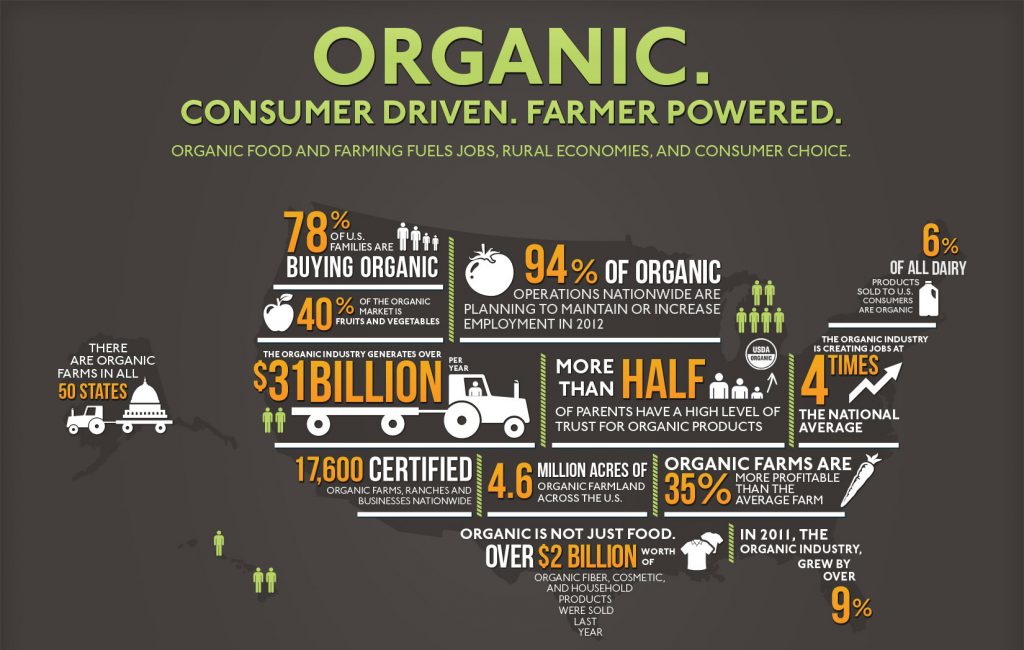How Organic Food Works
Organic farming was among the fastest growing segments of U.S. agriculture during the 1990s.
In December 2000, the National Organic Standards Board of the U.S. Department of Agriculture (USDA) established a national standard for the term “organic.” Organic food, defined by how it cannot be made rather than how it can be made, must be produced without the use of sewer-sludge fertilizers, most synthetic fertilizers and pesticides, genetic engineering (biotechnology), growth hormones, irradiation and antibiotics. A variety of agricultural products can be produced organically, including produce, grains, meat, dairy, eggs, and processed food products.
“Organic” does not mean “natural.” There is no legal definition as to what constitutes a “natural” food. However, the food industry uses the term “natural” to indicate that a food has been minimally processed and is preservative-free. Natural foods can include organic foods, but not all natural foods are organic. Only foods labeled “organic” have been certified as meeting USDA organic standards.
Standards vary worldwide, but organic farming in general features practices that strive to cycle resources, promote ecological balance, and conserve biodiversity.
Currently, the European Union, the United States, Canada, Mexico, Japan, and many other countries require producers to obtain special certification in order to market food as organic within their borders.
Organic Food Drive to Boost Sales
Food majors are aggressively trying to improve their products through innovations as well as strategic acquisitions and divestitures. Additionally, they are channeling funds toward product and packaging innovation as well as reformulating a number of existing products to meet the rapidly changing consumer view on health and wellness.
Given the scenario, demand for organic food continues to grow in the U.S. Per the recently released report from Organic Trade Association’s (OTA’s) 2017 Organic Industry Survey, the American organic sector stayed on its upward trajectory in 2016, gaining new market share and crushing records, as consumers across the country ate more organic products than ever before.
Total organic sales were $47 billion in 2016 in the U.S., reflecting new sales of nearly $3.7 billion. This comprised $43 billion of organic food sales, the first time the American organic food market has broken the $40-billion mark. Organic food sales increased 8.4% from 2016, significantly surpassing the stagnant 0.6% growth rate in the overall food market. Sales of organic non-food products increased 8.8% in 2016, outstripping the overall non-food growth rate of 0.8%.
Apart from innovations and the drive toward organic ingredients, companies are also pursuing a spate of multi-year restructuring initiatives with focus on improving operational efficiency to generate cost savings and supporting its key growth strategies.

Total organic sales were $47 billion in 2016 in the U.S., reflecting new sales of nearly $3.7 billion. This comprised $43 billion of organic food sales, the first time the American organic food market has broken the $40-billion mark
Organic Food as Investment
Organic food investing might be an area of budding growth for years to come.
“The overall food market grows at about 3 percent per year. The organic food market grows at about 15 percent per year, and it’s exclusively driven by consumer interest in healthy foods,” says Kevin Egolf, chief financial officer for Iroquois Valley Farms. “They make healthy food choices for a variety of reasons. Some are avoiding GMOs (genetically modified organisms), some want a more localized food supply, some want to avoid the applications of chemical pesticides and herbicides, and others for environmental reasons.”
If the U.S. follows Europe and strengthens food and GMO regulations, organics might gain even more strength.
“Europeans are already there; they don’t allow GMO products and put huge limits on pesticides and fungicides,” says Josh Strauss, co-chief executive officer of Pekin Singer Strauss Asset Management in Chicago. “And I think that as we learn more about food and its impact on health, we’re going to move more and more in that direction.”
“The overall food market grows at about 3 percent per year. The organic food market grows at about 15 percent per year, and it’s exclusively driven by consumer interest in healthy foods”
-Kevin Egolf, chief financial officer for Iroquois Valley Farms
Organic Food as a theme of investment for the wealthy families
Over the past few years, some Family Offices have decided to invest in Organic Food, spurred by the desire to diversify into a rapidly growing sector.
The emergence of financial instruments dedicated to this investment theme (ETFs), and the fact that food makers are going all out to boost the supply of organic ingredients – as well as increase investment in infrastructure and education – will stimulate further interest on the part of wealthy families to enter this sector.
Notes
5 Food Stocks for Healthy Gains on Organic Food Trend
http://www.nasdaq.com/article/5-food-stocks-for-healthy-gains-on-organic-food-trend-cm797964
How your recycling habits can affect the way you invest
Investing in Organic Foods
https://www.outsiderclub.com/investing-in-organic-foods/1786
ETFs are expanding into organic farming and other new trends
https://www.cnbc.com/2016/12/27/etfs-are-expanding-into-organic-farming-and-other-new-trends.html


